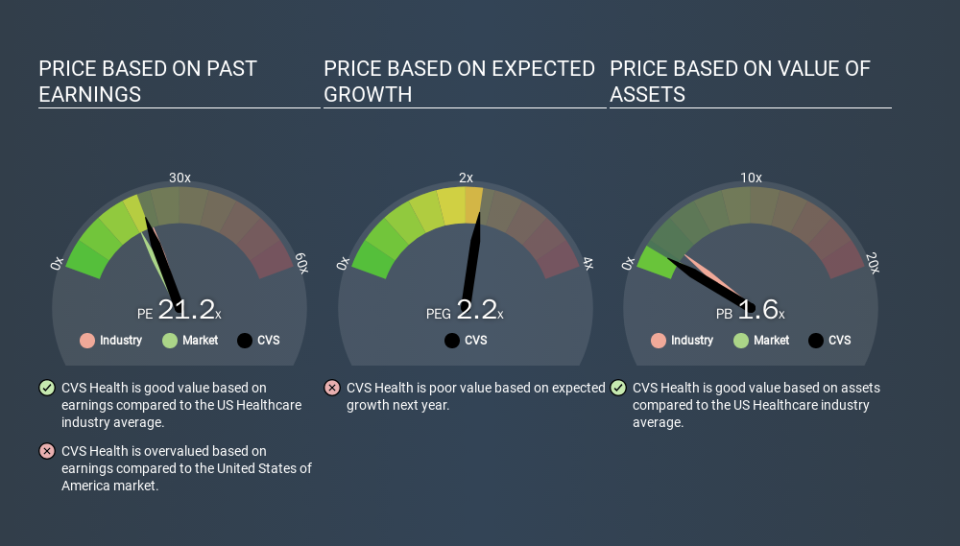Does CVS Health Corporation's (NYSE:CVS) P/E Ratio Signal A Buying Opportunity?

This article is written for those who want to get better at using price to earnings ratios (P/E ratios). We'll look at CVS Health Corporation's (NYSE:CVS) P/E ratio and reflect on what it tells us about the company's share price. Looking at earnings over the last twelve months, CVS Health has a P/E ratio of 21.20. That corresponds to an earnings yield of approximately 4.7%.
View our latest analysis for CVS Health
How Do I Calculate CVS Health's Price To Earnings Ratio?
The formula for P/E is:
Price to Earnings Ratio = Price per Share ÷ Earnings per Share (EPS)
Or for CVS Health:
P/E of 21.20 = $75.36 ÷ $3.56 (Based on the trailing twelve months to September 2019.)
Is A High Price-to-Earnings Ratio Good?
The higher the P/E ratio, the higher the price tag of a business, relative to its trailing earnings. That is not a good or a bad thing per se, but a high P/E does imply buyers are optimistic about the future.
Does CVS Health Have A Relatively High Or Low P/E For Its Industry?
We can get an indication of market expectations by looking at the P/E ratio. The image below shows that CVS Health has a P/E ratio that is roughly in line with the healthcare industry average (22.3).
Its P/E ratio suggests that CVS Health shareholders think that in the future it will perform about the same as other companies in its industry classification. So if CVS Health actually outperforms its peers going forward, that should be a positive for the share price. Further research into factors such as insider buying and selling, could help you form your own view on whether that is likely.
How Growth Rates Impact P/E Ratios
Companies that shrink earnings per share quickly will rapidly decrease the 'E' in the equation. Therefore, even if you pay a low multiple of earnings now, that multiple will become higher in the future. So while a stock may look cheap based on past earnings, it could be expensive based on future earnings.
Most would be impressed by CVS Health earnings growth of 17% in the last year. In contrast, EPS has decreased by 1.8%, annually, over 5 years.
A Limitation: P/E Ratios Ignore Debt and Cash In The Bank
One drawback of using a P/E ratio is that it considers market capitalization, but not the balance sheet. So it won't reflect the advantage of cash, or disadvantage of debt. Theoretically, a business can improve its earnings (and produce a lower P/E in the future) by investing in growth. That means taking on debt (or spending its cash).
Such spending might be good or bad, overall, but the key point here is that you need to look at debt to understand the P/E ratio in context.
How Does CVS Health's Debt Impact Its P/E Ratio?
Net debt totals 63% of CVS Health's market cap. This is enough debt that you'd have to make some adjustments before using the P/E ratio to compare it to a company with net cash.
The Verdict On CVS Health's P/E Ratio
CVS Health's P/E is 21.2 which is above average (18.5) in its market. It has already proven it can grow earnings, but the debt levels mean it faces some risks. But if growth falters, the relatively high P/E ratio may prove to be unjustified.
Investors should be looking to buy stocks that the market is wrong about. If the reality for a company is better than it expects, you can make money by buying and holding for the long term. So this free report on the analyst consensus forecasts could help you make a master move on this stock.
But note: CVS Health may not be the best stock to buy. So take a peek at this free list of interesting companies with strong recent earnings growth (and a P/E ratio below 20).
If you spot an error that warrants correction, please contact the editor at editorial-team@simplywallst.com. This article by Simply Wall St is general in nature. It does not constitute a recommendation to buy or sell any stock, and does not take account of your objectives, or your financial situation. Simply Wall St has no position in the stocks mentioned.
We aim to bring you long-term focused research analysis driven by fundamental data. Note that our analysis may not factor in the latest price-sensitive company announcements or qualitative material. Thank you for reading.

 Yahoo Finance
Yahoo Finance 
